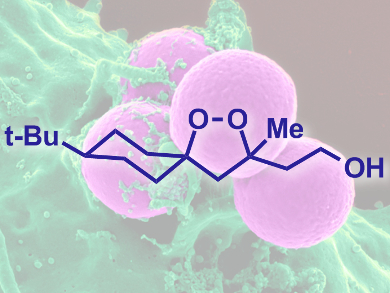Organic peroxides are not the first compounds that spring to mind when developing drugs, and they are often excluded from screening assays because of their perceived instability. Nature provides us with limited examples of biologically active peroxides, including the antimalarial drug artemisinin and the 1,2-dioxolane-containing plakinic acids.
Using these compounds as inspiration for their search for anticancer drugs, William Carroll, Keith Woerpel, and colleagues, New York University, USA, tested different 1,2-dioxolanes for cytotoxicity in 59 cell lines. Cytotoxic compounds often work by inducing programmed cell death (apoptosis), however, drug-resistant tumors can get around this. The most promising candidate in the screening (pictured) acted by a different mechanism known as ferroptosis, an iron-dependent pathway. Many cancer cells have elevated iron levels and this compound, “ferroptosis-inducing peroxide” (FINO2), displayed selective toxicity for cancer cells over non-cancer cells, with one of its enantiomers being particularly selective.
Compounds that act by unusual mechanisms are valuable and the researchers present evidence that FINO2 might work against tumors on which traditional drugs fail. Furthermore, like artemisinin, FINO2 is thermally stable, which suggests that organic peroxides should perhaps not be routinely excluded from screening for new drug candidates.
- Five-Membered Ring Peroxide Selectively Initiates Ferroptosis in Cancer Cells,
Rachel P. Abrams, William L. Carroll, K. A. Woerpel,
ACS Chem. Biol. 2016.
DOI: 10.1021/acschembio.5b00900





